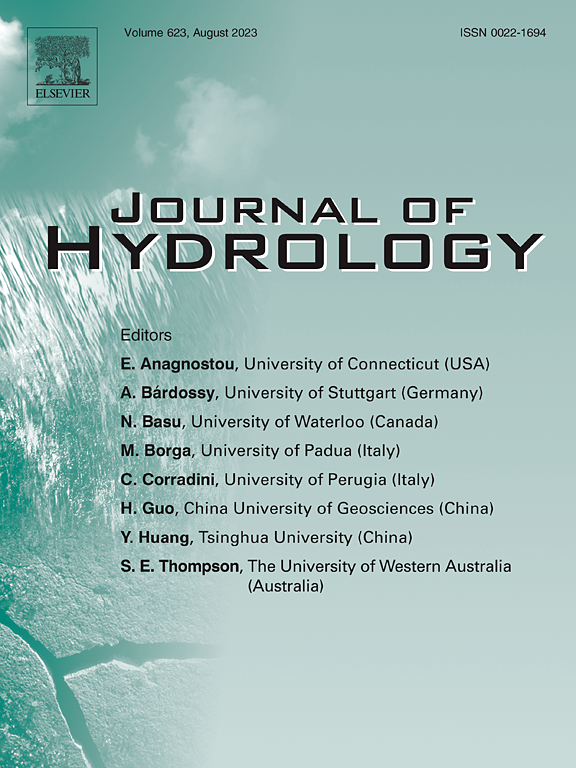岩溶节奏泉系统地下水停留时间的稳定同位素和热信号双示踪分析
IF 5.9
1区 地球科学
Q1 ENGINEERING, CIVIL
引用次数: 0
摘要
作为喀斯特系统虹吸-管腔耦合机制的一种水文地质表现,节奏泉结构对地下水蓄水动态的调节能力及其对停留时间分布的非均质控制尚不充分。以华南潮水洞岩溶节奏泉系统为研究对象,采用双示踪框架,将稳定的氢氧同位素和热特征与正弦传递函数和线性储层建模相结合。系统地收集了包括降水、地表水和地下水相在内的水文时序数据,以计算不同流态的平均停留时间(MRT),从而阐明虹吸-管道网络对含水层响应特征施加的结构控制。主要发现表明:(1)三种独立方法得出的MRT估算方法的一致性,揭示了MRT大于198-213天的浅层循环路径(29.5-60 d)深层循环油藏;(2)观测到的热示踪峰与稳定同位素特征之间约40天的相位滞后表明,沿着分层结构的地下水流道,对流传导传热机制存在差异;(3)通过对CSD泉断流峰值温度和流道上游相应地下水温度的分析,估计虹吸管腔控制断流时的峰值流量约为10%的基流和90%的深循环地下水。此外,水在虹吸管腔结构内的停留时间约为279天。这一观察结果表明,虹吸腔作为地下水的临时储存和混合水库,从而延长了水流的持续时间。此外,这一发现强调了温度示踪在量化不同地下水来源混合比方面的有效性。该研究有助于加深对复杂岩溶盆地水循环的认识,并扩展了环境同位素在地下水研究中的应用。本文章由计算机程序翻译,如有差异,请以英文原文为准。
Dual-tracer analysis of stable isotopes and thermal signals to quantify groundwater residence times in karst rhythmic spring systems
As a hydrogeological manifestation of siphon conduit-cavity coupling mechanisms in karst systems, the regulatory capacity of rhythmic spring structures on groundwater storage dynamics and their heterogeneous controls on residence time distributions remain insufficiently quantified. Focusing on the Chaoshuidong (CSD) karst rhythmic spring system in southern China, this study employs a dual-tracer framework integrating stable hydrogen–oxygen isotopes and thermal signatures with sinusoidal transfer functions and linear reservoir modeling. Hydrological time-series data encompassing precipitation, surface water, and groundwater phases were systematically collected to compute mean residence times (MRT) across distinct flow regimes, thereby elucidating structural controls imposed by siphon-conduit networks on aquifer response characteristics. Key findings demonstrate: (1) Methodological coherence in MRT estimates derived from three independent approaches, revealing shallow circulation pathways (29.5–60 d) deep circulation reservoirs with MRT greater than 198–213 days; (2) The observed approximately 40 day phase lag between thermal tracer peaks and stable isotope signatures demonstrates differential advective-conductive heat transfer mechanisms along hierarchically structured groundwater flow paths; (3) Through analysis of the peak temperatures during intermittent discharges at the CSD spring and the corresponding groundwater temperatures upstream of the flow path, the peak discharge during the siphon conduit-cavity controlled intermittent outflow was estimated to consist of approximately 10 % base flow and 90 % deep-circulating groundwater. Furthermore, the water residence time within the siphon conduit-cavity structure was determined to be approximately 279 days. This observation indicates that siphon cavities function as temporary storage and mixing reservoirs for groundwater, thereby prolonging flow duration. Furthermore, this finding underscores the efficacy of temperature tracing in quantifying the mixing ratios of diverse groundwater sources. This study contributes to an enhanced understanding of water cycling within complex karst basins and extends the application of environmental isotopes to groundwater research.
求助全文
通过发布文献求助,成功后即可免费获取论文全文。
去求助
来源期刊

Journal of Hydrology
地学-地球科学综合
CiteScore
11.00
自引率
12.50%
发文量
1309
审稿时长
7.5 months
期刊介绍:
The Journal of Hydrology publishes original research papers and comprehensive reviews in all the subfields of the hydrological sciences including water based management and policy issues that impact on economics and society. These comprise, but are not limited to the physical, chemical, biogeochemical, stochastic and systems aspects of surface and groundwater hydrology, hydrometeorology and hydrogeology. Relevant topics incorporating the insights and methodologies of disciplines such as climatology, water resource systems, hydraulics, agrohydrology, geomorphology, soil science, instrumentation and remote sensing, civil and environmental engineering are included. Social science perspectives on hydrological problems such as resource and ecological economics, environmental sociology, psychology and behavioural science, management and policy analysis are also invited. Multi-and interdisciplinary analyses of hydrological problems are within scope. The science published in the Journal of Hydrology is relevant to catchment scales rather than exclusively to a local scale or site.
 求助内容:
求助内容: 应助结果提醒方式:
应助结果提醒方式:


